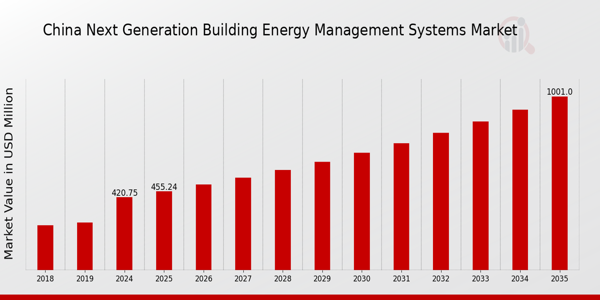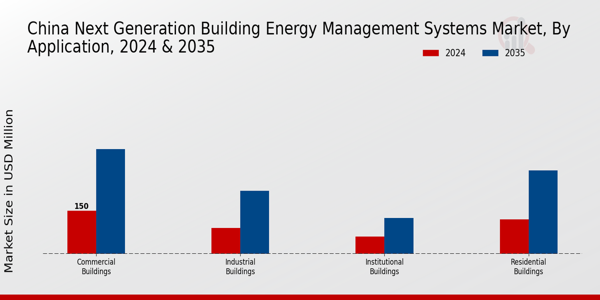China Next Generation Building Energy Management Systems Market Overview
As per MRFR analysis, the China Next Generation Building Energy Management Systems Market Size was estimated at 388.5 (USD Million) in 2023.The China Next Generation Building Energy Management Systems Market Industry is expected to grow from 420.75(USD Million) in 2024 to 1,001 (USD Million) by 2035. The China Next Generation Building Energy Management Systems Market CAGR (growth rate) is expected to be around 8.198% during the forecast period (2025 - 2035).
Key China Next Generation Building Energy Management Systems Market Trends Highlighted
The market for China Next Generation Building Energy Management Systems is greatly affected by the country's increased focus on sustainability and energy efficiency. The Chinese government has made protecting the environment and saving energy a top priority, partly because it wants to be carbon neutral by 2060. Because of this regulated framework, businesses are more likely to use advanced building energy management systems to meet national and local energy-saving goals. Recent trends reveal that these systems are using more Internet of Things (IoT) technology, which lets them monitor and optimize energy use in real time in homes and businesses.
There is an increasing need for smart buildings, especially in cities where energy use is high. This tendency is backed by the fact that more and more people are moving to cities in China. This is causing more commercial developments to need energy management solutions that work well. Also, the rise of smart city projects in several Chinese provinces is making room for new ways to control building energy, which will help with tracking energy use and distribution. Also, the market is moving toward predictive analytics and artificial intelligence technologies that make operations more efficient and waste less energy.
This shift toward automation in energy management systems gives businesses the tools they need to proactively monitor their energy use and cut costs. The focus on renewable energy sources also makes things better, since integrating them with building energy management systems can substantially improve efforts to make energy use more sustainable. Overall, the Next Generation Building Energy Management Systems Market in China is likely to increase because of these changing patterns and the country's goals for making energy use more efficient.

Source: Primary Research, Secondary Research, MRFR Database and Analyst Review
China Next Generation Building Energy Management Systems Market Drivers
Government Initiatives for Energy Efficiency
In recent years, the Chinese government has launched several initiatives aimed at promoting energy efficiency in buildings. As part of the 13th Five-Year Plan, the government has targeted a 15% reduction in energy consumption per unit of GDP by 2020 compared to 2015 levels.
Moreover, specific policies, including the Green Building Action Plan, emphasize energy-efficient building standards and regulations. Organizations like the Ministry of Housing and Urban-Rural Development are playing a crucial role in enforcing these regulations and increasing the awareness of next generation building energy management systems.As China's urban population continues to increase, with projections suggesting that 70% of the population will live in cities by 2030, the demand for effective energy management systems is expected to rise significantly, thus driving the market.
Growing Demand for Sustainable Solutions
The growing emphasis on sustainability within construction and management sectors in China has resulted in increased adoption of next generation energy management solutions. According to the China Green Building Council, the number of certified green buildings has doubled over the past five years, highlighting a technological shift toward eco-friendly practices.
Contemporary trends are also showing that companies adopting sustainable energy solutions see a return on investment of up to 30% within the first three years.This trend is largely supported by the heightened awareness of climate change impacts, as public and private organizations gear towards sustainable building practices, significantly influencing the China Next Generation Building Energy Management Systems Market Industry.
Advancements in Smart Technologies
Recent advancements in smart technologies, such as the Internet of Things (IoT) and Artificial Intelligence (AI), are contributing positively to the China Next Generation Building Energy Management Systems Market. IoT-enabled systems provide real-time data regarding energy consumption and efficiency, allowing businesses to optimize their energy use.
According to the China Electronics Technology Group Corporation, the country is projected to see a rapid increase in smart building technology, predicting a 25% growth rate in smart lighting and control systems by 2025.As leading companies, including Huawei and Alibaba, push for innovation in this space, the integration of smart technologies into energy management systems becomes essential for effective solutions, thereby boosting market growth.
China Next Generation Building Energy Management Systems Market Segment Insights
Next Generation Building Energy Management Systems Market Application Insights
The application segment of the China Next Generation Building Energy Management Systems Market plays a pivotal role in driving energy efficiency and sustainability across different building types. This market encompasses various applications including residential, commercial, industrial, and institutional buildings, each uniquely contributing to the overall demand for sophisticated energy management solutions. With the growing urbanization and increasing energy consumption in China, residential buildings have emerged as a critical area, where advanced energy management systems contribute to increased comfort, efficiency, and reduced energy bills for homeowners.
Meanwhile, commercial buildings are significantly leveraging these systems to optimize energy use in real-time, thereby reducing operational costs and enhancing environmental sustainability. Industrial buildings are seeing a rise in adoption of next-generation energy management technologies, largely due to stringent regulatory frameworks aimed at reducing carbon emissions and enhancing operational efficiency. These technologies facilitate smart controls and data analytics that help in managing complex energy requirements effectively.
The institutional buildings segment represents a substantial opportunity, as schools, hospitals, and government facilities seek to enhance their energy efficiency to meet sustainability goals and comply with local regulations. In China, the government has been promoting institutional energy efficiency through various initiatives, which further boosts the demand for sophisticated energy management systems.
Overall, the diverse application landscape in the China Next Generation Building Energy Management Systems Market demonstrates the significant potential for energy savings, operational efficiency, and environmental benefits across various types of buildings, as each segment continues to evolve with enhanced technological solutions tailored to their specific needs. As organizations and residents increasingly prioritize energy conservation and carbon footprint reduction, the overarching demand for intelligent building energy management solutions will likely continue to strengthen across all applications.

Source: Primary Research, Secondary Research, MRFR Database and Analyst Review
Next Generation Building Energy Management Systems Market Technology Insights
The Technology segment of the China Next Generation Building Energy Management Systems Market plays a crucial role in optimizing energy use, improving efficiency, and enhancing sustainability in buildings across the country. This segment primarily consists of various approaches, including Cloud-Based, On-Premises, and Hybrid systems. Cloud-Based solutions are gaining traction due to their scalability and ability to facilitate remote monitoring and management, which aligns with China’s growing emphasis on smart city initiatives.
On-Premises systems remain popular in sectors where data security and regulatory compliance are paramount, providing organizations with greater control over their operations.Meanwhile, Hybrid systems combine both Cloud and On-Premises features, offering flexibility and versatility that appeals to a broad range of users. Each approach addresses unique challenges and opportunities in energy management, reflecting the diverse needs of the Chinese market.
Factors such as increasing energy costs, stringent government regulations on energy efficiency, and rising environmental awareness among organizations catalyze the growth of these technological solutions, positioning them as fundamental components for future developments in the China Next Generation Building Energy Management Systems Market.
Next Generation Building Energy Management Systems Market Component Insights
The Component segment of the China Next Generation Building Energy Management Systems Market encompasses various critical elements like Software, Hardware, and Services, each contributing significantly to the overall efficiency and growth of energy management solutions. Software plays a vital role in delivering sophisticated analytics and operational control, enhancing the functionality of energy systems in buildings.
Hardware, which includes advanced sensors and devices, supports real-time monitoring and automation, ensuring effective energy consumption.Services associated with this market, such as installation, maintenance, and consulting, are essential for optimizing operational performance and achieving energy savings. The growing demand for smart buildings and the adoption of Internet of Things (IoT) technologies in China are strong drivers for this segment.
Moreover, governmental initiatives aimed at improving energy efficiency and sustainability further bolster the relevance of this segment in achieving the nation's environmental goals. The emphasis on renewable energy adoption and energy management presents abundant opportunities for innovation and service enhancement within this component landscape.Overall, this segment forms the backbone of the China Next Generation Building Energy Management Systems Market, playing a core role in its development and evolution.
Next Generation Building Energy Management Systems Market End Use Insights
The End Use segment of the China Next Generation Building Energy Management Systems Market is essential in driving energy efficiency and operational excellence across various industries. The significance of Energy Management within this segment is notable, considering China's stringent energy regulations and the growing emphasis on sustainability. Operational Efficiency focuses on enhancing performance and reducing waste, aligning well with China’s goals to modernize and innovate in building infrastructure.
Regulatory Compliance plays a crucial role as businesses seek to adhere to government mandates and standards aimed at reducing carbon footprints.These elements not only support a more sustainable environment but also present significant opportunities for technological advancement. As organizations in China increasingly recognize the value of implementing integrated building management systems, the demand is expected to rise, fostering a landscape ripe for innovation and investment in advanced energy solutions. The combination of regulatory pressures and the quest for operational efficacy underlies the importance of the End Use segment in shaping the future of building energy management in China.
China Next Generation Building Energy Management Systems Market Key Players and Competitive Insights
The China Next Generation Building Energy Management Systems Market is witnessing a robust transformation characterized by the integration of advanced technologies such as Internet of Things (IoT), Artificial Intelligence (AI), and big data analytics. The competitive landscape in this market is shaped by the increasing demand for energy efficiency, regulatory support for sustainable practices, and an upsurge in smart building initiatives.
Companies are striving to innovate their product offerings, enhance customer experience, and leverage data-driven insights to optimize building operations while managing energy consumption effectively. The growing emphasis on reducing carbon emissions among various industries in China fuels the competition as organizations seek to differentiate themselves through technological superiority and service excellence.
Siemens has carved out a prominent position in the China Next Generation Building Energy Management Systems Market, renowned for its comprehensive suite of digital building solutions. The company's key products and services revolve around smart building technologies that encompass energy management, automation, and efficient operational processes. Siemens distinguishes itself through its commitment to innovation, as seen in its continuous product development and integration of cutting-edge technologies. The company's extensive market presence is bolstered by strategic mergers and acquisitions that have expanded its technological capabilities and local expertise.
Siemens partners with various stakeholders, including government entities and private firms, to promote energy efficiency and sustainability. These collaborative efforts not only enhance Siemens' market penetration but also strengthen its reputation as a leader in transforming building operations in alignment with China's ambitious energy goals, reaffirming its strengths in delivering tailored solutions that address the growing demand for intelligent energy management.
Key Companies in the China Next Generation Building Energy Management Systems Market Include:
- Siemens
- Eaton
- Honeywell Building Solutions
- Cisco
- BuildingIQ
- Trane
- IBM
- Schneider Electric
- Johnson Controls
- Honeywell
China Next Generation Building Energy Management Systems Market Industry Developments
The China Next Generation Building Energy Management Systems Market has been witnessing significant growth and developments lately. Recent reports indicate that companies like Siemens and Honeywell Building Solutions are investing heavily in smart building technologies, aligning with China's commitment to sustainability and energy efficiency.
Additionally, Eaton and Schneider Electric have been actively collaborating with local stakeholders to integrate renewable energy sources into their building management systems. There were also noteworthy acquisitions; Trane acquired a local energy management firm in April 2023, strengthening its foothold in the region.
The market is also marked by the rising importance of digital transformation, as companies like IBM and Cisco are driving innovations through Artificial Intelligence and Internet of Things technologies. Major events in the last couple of years, including regulatory support from the Chinese government for energy-efficient building practices, underscore the urgency for next-generation solutions in energy management.
China Next Generation Building Energy Management Systems Market Segmentation Insights
Next Generation Building Energy Management Systems Market Application Outlook
-
- Residential Buildings
- Commercial Buildings
- Industrial Buildings
- Institutional Buildings
Next Generation Building Energy Management Systems Market Technology Outlook
-
- Cloud-Based
- On-Premises
- Hybrid
Next Generation Building Energy Management Systems Market Component Outlook
-
- Software
- Hardware
- Services
Next Generation Building Energy Management Systems Market End Use Outlook
-
- Energy Management
- Operational Efficiency
- Regulatory Compliance
| Report Attribute/Metric Source: |
Details |
| MARKET SIZE 2023 |
388.5(USD Million) |
| MARKET SIZE 2024 |
420.75(USD Million) |
| MARKET SIZE 2035 |
1001.0(USD Million) |
| COMPOUND ANNUAL GROWTH RATE (CAGR) |
8.198% (2025 - 2035) |
| REPORT COVERAGE |
Revenue Forecast, Competitive Landscape, Growth Factors, and Trends |
| BASE YEAR |
2024 |
| MARKET FORECAST PERIOD |
2025 - 2035 |
| HISTORICAL DATA |
2019 - 2024 |
| MARKET FORECAST UNITS |
USD Million |
| KEY COMPANIES PROFILED |
Roper Technologies, Siemens, Eaton, Honeywell Building Solutions, KMC Controls, Lutron Electronics, Cisco, BuildingIQ, Trane, IBM, Savant Systems, Schneider Electric, Johnson Controls, Honeywell, Delta Electronics |
| SEGMENTS COVERED |
Application, Technology, Component, End Use |
| KEY MARKET OPPORTUNITIES |
Increasing government sustainability initiatives, Rising demand for energy efficiency, Integration with IoT technologies, Expanding smart building infrastructure, Growing investment in renewable energy |
| KEY MARKET DYNAMICS |
growing energy efficiency demand, government regulations and incentives, advanced technology integration, increased focus on sustainability, rising urbanization and smart cities |
| COUNTRIES COVERED |
China |
Frequently Asked Questions (FAQ):
The expected market size in 2024 is valued at 420.75 million USD.
By 2035, the market is expected to reach a valuation of 1001.0 million USD.
The expected CAGR for the market is 8.198 percent from 2025 to 2035.
The Commercial Buildings segment is projected to have the highest market value at 365.0 million USD by 2035.
The estimated market value for Residential Buildings in 2035 is 290.0 million USD.
Key players include Roper Technologies, Siemens, Eaton, Honeywell Building Solutions, and Schneider Electric.
The market value for Industrial Buildings in 2024 is estimated at 90.75 million USD.
The projected market value for Institutional Buildings by 2035 is 126.0 million USD.
The market value for Commercial Buildings is expected to increase from 150.0 million USD in 2024 to 365.0 million USD in 2035.
Challenges include technological advancements, regulatory changes, and market competition in a rapidly evolving environment.
















